- Home
- About Journals
-
Information for Authors/ReviewersEditorial Policies
Publication Fee
Publication Cycle - Process Flowchart
Online Manuscript Submission and Tracking System
Publishing Ethics and Rectitude
Authorship
Author Benefits
Reviewer Guidelines
Guest Editor Guidelines
Peer Review Workflow
Quick Track Option
Copyediting Services
Bentham Open Membership
Bentham Open Advisory Board
Archiving Policies
Fabricating and Stating False Information
Post Publication Discussions and Corrections
Editorial Management
Advertise With Us
Funding Agencies
Rate List
Kudos
General FAQs
Special Fee Waivers and Discounts
- Contact
- Help
- About Us
- Search

Open Urban Studies and Demography Journal
(Discontinued)
ISSN: 2352-6319 ― Volume 4, 2018
Forgetting the City: Tactics of Transformation of the City in Motion
Minas Bakalchev1, *, Violeta Bakalchev2, Saša Tasić1
Abstract
We conceive the city not only as a material creation but also as a collective memory created in time and through time. While the material aspect is susceptible to continuous changes, the conceptual aspect is the one that permanently reconstructs the image of the city. But, what if the physical transformations of the city become too large, too deviant? What if the collective memory cannot reconstruct the images of the city in that continuously metastable context? What if the city loses its memory, what if it loses the ability for creating a new memory, partial or total inability to recall recent memory. Using the recent history of Skopje as an example, the dramatic history of forgetting the city will be presented. The entire twentieth century was marked by a series of innovative attempts toward reformulation of the city. The result of a century of modernization is a city composed from different cities, different sections, scales, figures these are the different traces of ideas about the city, witnessing a continuous forgetting of the city. Can forgetting be the model of perception and transformation of the city? Can forgetting as an expression of destruction become a model of reconstruction of the city? Can forgetting bring reading the city again? The subject of the present paper IS the forgotten urban pockets and the possible tactics of transformation. In absence of master procedures, through a series of everyday tactics, we shall explore the possibilities of forgetting as a motion toward essential images of space.
Article Information
Identifiers and Pagination:
Year: 2015Volume: 1
Issue: Suppl 1-M8
First Page: 72
Last Page: 83
Publisher Id: OUSDJ-1-72
DOI: 10.2174/2352631901401010072
Article History:
Received Date: 10/6/2015Revision Received Date: 15/6/2015
Acceptance Date: 15/6/2015
Electronic publication date: 31/12/2015
Collection year: 2015
open-access license: This is an open access article licensed under the terms of the Creative Commons Attribution-Non-Commercial 4.0 International Public License (CC BY-NC 4.0) (https://creativecommons.org/licenses/by-nc/4.0/legalcode), which permits unrestricted, non-commercial use, distribution and reproduction in any medium, provided the work is properly cited.
* Address correspondence to this author at the “Ss.Cyril and Methodius” University, Faculty of Architecture, Skopje, Republic of Macedonia; Tel: +389 (2) 3164 - 974; E-mail: minasbakalcev@gmail.com
| Open Peer Review Details | |||
|---|---|---|---|
| Manuscript submitted on 10-6-2015 |
Original Manuscript | Forgetting the City: Tactics of Transformation of the City in Motion | |
1. REMEMBERING AND FORGETTING
We undoubtedly live in a world of changes. The dramatic changes of the modern city, its instability, temporariness and fragmentation make us contemplate again about the city architecture, the way it is established and changed. Although presently there are many theories about the metastability of the architectonic form and the relationship between social changes and the spatial frame, it seems that one cannot explain completely the specificities and the modes in which the physical structure of our environment is changed as well as the excessiveness and the bizarreness of the transformation of the city architecture. We can unquestionably agree with a number of assertions, historical and modern, about the correlation between the social and the spatial context, cities as visible political programs, as mirrors of the society and the ruling systems of the countries in which they are located [1Nowak W. Foreword. In: Bardett R, Sudjic D, Eds. Living in The Endless City. London: Phaidon Press Limited 2011; p. 6.], but we are also witnesses of the displacement of the transformation of our physical contexts that surpass the initial cause- effect assumptions. How can we understand the changes in which everything is allowed? Can we still talk about architecture of the city in the sense of its continuity? Can we still describe the transformation of the city as an emancipation from a certain historic backwardness?
The seventies of the twentieth century saw the first critical theories of the modern discourse through which the city is conceived as a complex and contradictory configuration. Aldo Rossi pointed out the double nature of the city through history: the city as a material artifact, an artifact structure built through time, AND also the city as a collective conception which does not refer only to the real structure of the city but also the idea about it. To that effect, even in periods of decline of cities, it is possible to distinguish the “almost a typological characteristic, of an undefinable order” [2Rossi A. The Architecture of the City. UK: The MIT Press 1982.]. The concept of collective memory, which Aldo Rossi introduces in the discourse on the architecture, points out the complementary character of the image of the city composed of a dialogue between material and immaterial values, a synthesis of a series of values referring to the collective imagination:
“One can say that the city itself is the collective memory of its people, and like memory, it is associated with objects and places” [2Rossi A. The Architecture of the City. UK: The MIT Press 1982.].
Aldo Rossi was the one that apostrophized the enigmatic thought about forgetting the architecture. In his book “A Scientific Autobiography”, he posed the question about forgetting as an alternative title of his autobiographic work:
“As I have said, Forgetting Architecture comes to mind as a more appropriate title for this book, since while I may talk about a school, a cemetery, a theatre, it is more correct to say that I talk about life, death, imagination” [3Rossi A. A Scientific Autobiography. UK: The MIT Press 1984.].
He connected the forgetting of architecture issue with at least three ways of interpretation of the architecture. First, withdrawal from architecture and its contents (“since while I may talk about a school, a cemetery, a theatre, it is more correct to say that I talk about life, death, imagination”). Second, transition from one way of representation into another as the ambivalence of expression of a certain work:
“To forget architecture, or any proposition, was the objective of my unchanging choice of typology of pictorial and graphic construction in which the graphics became confused with handwriting, as in certain highly developed forms of graphic obsession where the marks may be seen as either drawing or writing” [3Rossi A. A Scientific Autobiography. UK: The MIT Press 1984.].
Third, the loss of identity as a multitude of associations with which an object is connected:
“Forgetting is also associated with a loss of our own identity and that of the things we observe; every change occurs within a moment of obsession” [3Rossi A. A Scientific Autobiography. UK: The MIT Press 1984.].
In all three cases, the main characteristics of the architecture in the sense of object, expression and initial original situation are forgotten, left behind. Forgetting is understood as withdrawal, leaving behind, surmounting or loss of an initial state which happens within a “moment of obsession”. In that way, Aldo Rossi connects the notion of forgetting with the state of obsession.
But, is forgetting part of the mode in which the city is transformed? Can forgetting be a model of perception and transformation of the city? Can forgetting as an expression of destruction become a model of reconstruction of the city? It is exactly the concept of forgetting architecture that we have tried to connect with its progressive transformation.
In biological sense, forgetting refers to loss of information, encoded and stored in the long term memory of an individual. It is a spontaneous or gradual process through which old memories are unable to be recalled from the memory storages [4Maddox GB, Balota DA, Coane JH, Duchek JM. The role of forgetting rate in producing a benefit of expanded over equal spaced retrieval in young and older adults. Psychol Aging 2011; 26(3): 661-70. [Online]. [. Available from: http://en.wikipedia.org/wiki/Forgetting].
[http://dx.doi.org/10.1037/a0022942] [PMID: 21463056] ]. Forgetting means complete or partial, permanent or temporary loss of memories; inability to reproduce or recognize, reconstruct old memories.
The sociologist Paul Connerton points out that forgetting is not always a setback and that we should not always consider it as a weakness [5Connerton P. Seven types of forgetting. Mem Stud 2008; 1: 59. [Accessed October 2014].
[http://dx.doi.org/10.1177/1750698007083889] ]. According to Connerton, forgetting is more than the individual’s inability to remember pieces of the individual’s history. Forgetting is a complex process, whose first effect is anonymization of the local geographical space in the eyes of the individual. To that effect, it is useful to understand the different meanings of the common notion of forgetting. He suggests a taxonomy of forgetting related to different values, functions and factors: forgetting as repressive erasure; prescriptive forgetting;
forgetting that is constitutive in the formation of a new identity; structural amnesia; forgetting as annulment; forgetting as planned obsolescence; and forgetting as humiliated silence [5Connerton P. Seven types of forgetting. Mem Stud 2008; 1: 59. [Accessed October 2014].
[http://dx.doi.org/10.1177/1750698007083889] ]. Connerton suggests seven types of forgetting:
1. Repressive erasure refers to forgetting and erasure of persons, events, historic episodes that deny the facts of an imposed historic narrative.
2. Prescriptive forgetting refers to suppressing and forgetting certain historic events and it is different from repressive erasure because it is believed to be of interest for all the participants in a certain historic situation.
3. Forgetting that is constitutive in the formation of a new identity refers to discarding memories that are of no practical importance in managing the new identity.
4. Structural amnesia represents a tendency to remember only those connections, persons, events, pictures that are socially, culturally important.
5. Forgetting as annulment, originates from a surplus of information. Modern culture of hyperproduction of information leads to the necessity for their discarding.
6. Forgetting as planned obsolescence, arises from the system of consuming. Consumerism means forgetting in the interest of continuing to consume products that are not meant to last long.
7. Forgetting as humiliated silence refers to a secret silence, arising from a collective embarrassment that can be described as a wish to forget and as actual forgetting.
Different types of forgetting are associated with different subjects (factors), functions and values and refer to different social segments, a collective, but also an individual. The important thing for us is the way in which forgetting is identified and operationalized in the historic sequences of the city architecture.
2. METAMORPHOSIS
Through time, the city always undergoes changes in the most unexpected way. Transformation as reutilization, metamorphosis, superposition, juxtaposition are the modes in which an architectonic theme goes through time. In the seventies of the twentieth century, it was for the first time that the theme of transformation of the architectonic form was established as a way of generation of the city and a criticism of the model of rational planning. Both typo-morphological and structuralistic approaches recognized the dramatics of transformation of the initial form. A number of monumental structures from the past were the subject of progressive transformation in transitional periods of history. Although these were architectonic types with precise indicative form, structure and function, they were absorbed or transformed into other purposes and structures. Aldo Rossi states the transformation of the theatre in Nimes [2Rossi A. The Architecture of the City. UK: The MIT Press 1982.]. When at the end of the Roman period, the cities established their new boundaries by their fortification, they usually covered an area smaller than the former area of the Roman cities. In Nimes, the Theatre was transformed into a city, a theatre-city as a fortress to enclose and defend the citizens. Herman Hertzberger states the examples of the amphitheatres in Arles and Lucca as identical initial forms (Fig. 1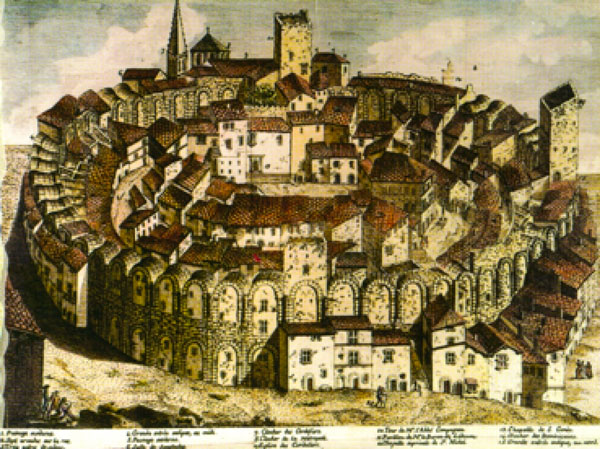 ).
).
 |
Fig. (1) Theatre-city, the amphitheatre in Arles before clearance of houses (prior to 1825) [7]. |
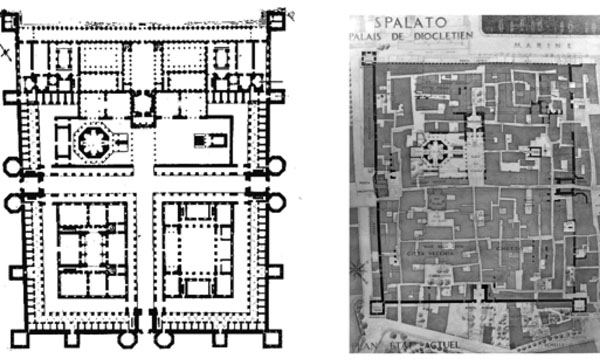 |
Fig. (2) Diocletian’s Palace, metamorphosis: from an emperor’s home to a city for many citizens [8]. |
 |
Fig. (3) Plan of Skopje XIX, traditional city prior to the beginning of modernization. |
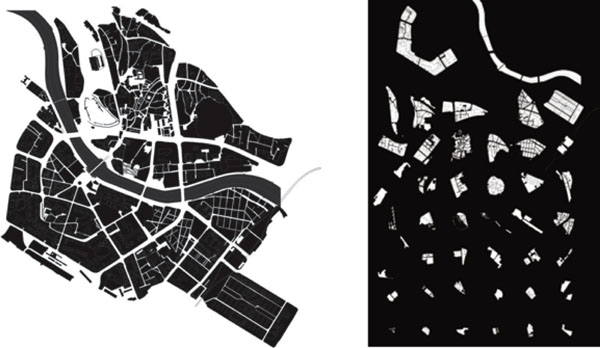 |
Fig. (5) Skopje, city of fragments/collection of different pieces. |
 |
Fig. (6) City fragments as infinitely different and separated worlds, Skopje (City of Possible Worlds, Venice Biennial, 2006). |
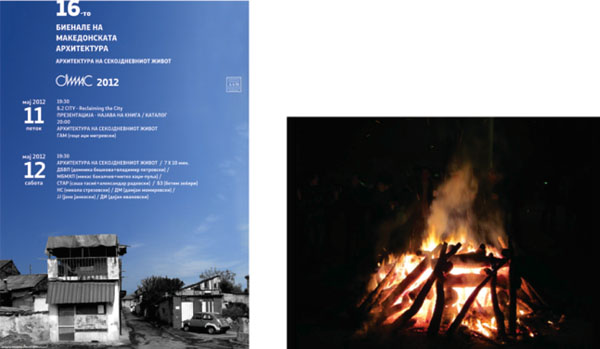 |
Fig. (7) Novo Maalo neighborhood on the poster “Architecture of Everyday Life”, 16 Biennial of Macedonian Architecture, 2012; Christmas Eve fires in Skopje neighborhoods. |
 |
Fig. (8) “Star”: Intersection of streets in Novo Maalo neighborhood. |
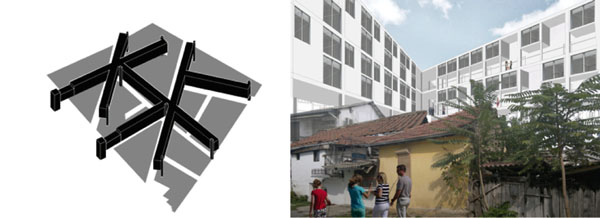 |
Fig. (10) Tactics of Uplifting the Streets, Kristijan Mitrevski (master thesis project), 2013. |
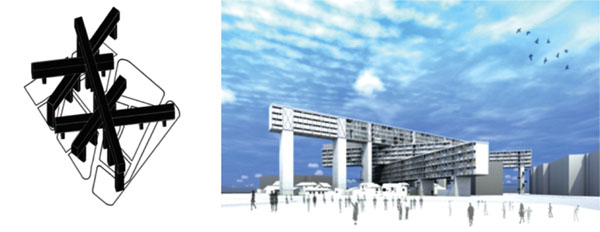 |
Fig. (11) Tactic of Layering the Streets, Katerina Elezi (master thesis project), 2013. |
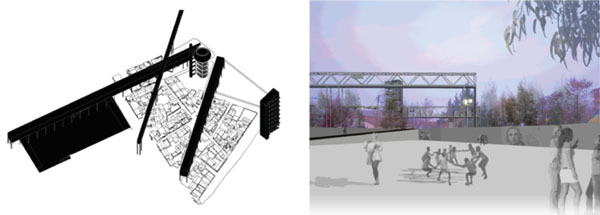 |
Fig. (12) Upgrading Novo Maalo, tactic of partial overbuilding of the streets and their connection with the surrounding referent positions of the city, Gordan Petrov (master thesis project), 2013. |
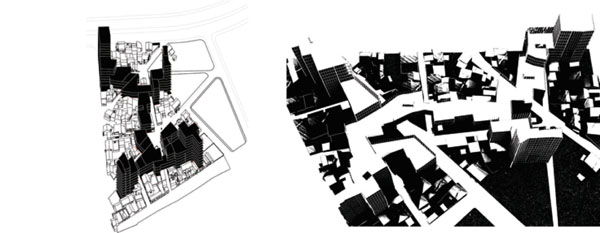 |
Fig. (13) Rhizomatic configuration, tactics of sequential connection of lots, aurora saidi (master thesis project), 2013. |
 |
Fig. (14) Linear configuration as incision, cutting of the city, aleksandar petanvoski (master thesis project), 2013. |
 |
Fig. (15) “Memento”, the body as a record, mnemotechnical tool (Memento, 2000, Christopher Nola, USA) [12]. |
 |
Fig. (16) Memento: Forgetting as remembrance (Memento, 2000. Christopher Nola, USA) [12]. |
In the case of Arles, it was transformed into a fortified city, while in the case of Lucca, it was absorbed in the city texture, remaining a public space at the same time [6Hertzberger H. Lessons for students in architecture 1991.]. So both amphitheatres intended for the same function obtained different role in history as a consequence of events that were beyond them. Both Aldo Rossi [2Rossi A. The Architecture of the City. UK: The MIT Press 1982.] and Herman Hertzberger [6Hertzberger H. Lessons for students in architecture 1991.] state the example of the Diocletian’s Palace, which was turned from an emperor’s palace into a city for many people in the same way (Fig. 2 ). The city of Split developed within the ramparts of the Diocletian’s Palace and provided new use and new meaning to the unchangeable form. In all cases, the architecture of the urban artifacts occurred as dynamics of
). The city of Split developed within the ramparts of the Diocletian’s Palace and provided new use and new meaning to the unchangeable form. In all cases, the architecture of the urban artifacts occurred as dynamics of
the city in which the widest adaptability of the multitude of functions corresponded with the permanency of form.
Although these urban transformations are the subject of a number of interpretations of the relation between function
and form, the ambivalence of form in respect to use, the possibility for different interpretation of the structure, a number of questions still remain open for discussion. Why and in which way a particular transformation of initial use and form takes place? Why do certain evident structural properties remain while some are subverted and lost? Although in a number of cases, these controversial processes can be explained by utilitarian, material, symbolic, aesthetic reasons, they still do not provide a complete response as to why certain areas, certain urban artifacts with a certain spatial logic cannot be transferred to subsequent historic periods.
Regarding the transformation of the amphitheatres in Arles and Lucca, Herman Hertzberger writes: “The original function is forgotten, but the amphitheatre-shape retains its relevance because it is so suggestive as to offer opportunities for constant renewal” [6Hertzberger H. Lessons for students in architecture 1991.]. From the aspect of the Connerton’s concept of forgetting, these transformations of urban artifacts can be related to structural amnesia as well as forgetting that is constitutive in the formation of a new identity. Structural amnesia has the tendency of remembering dominant episodes, persons and events. At the level of material artifacts, these are the essential characteristics of a form through which new interpretations can be re-constructed. As much is the reduction of the urban artifacts of only dominant formal, material values an expression of the Gestalt principles of perception, it is also a mode of discarding, forgetting the complex social and cultural aspect of a reality. In a similar way, the constituting of new social identities results in discarding of old spatial and socio-cultural models and opening to new narratives.
3. RING
The example of the city of Skopje will be used for showing the semantic and material transition of an urban element in the period of its modernization [9Bakalchev M. Housing as urban fragment of Skopje taken as an
example (in Macedonian) “SS Cyril and Methodius” University of
Skopje: Faculty of Architecture 2004, Unpublished doctoral dissertation . 2004.]. The transition of a traditional Balkan city to a modern city undoubtedly arouses a number of controversies (Fig. 3 , Fig. 5
, Fig. 5 ).
).
The history of the city is seen as a series of extraordinary attempts resulting in a complex contradictory fragmentary base: traditional city of XIX-XX; city with introduced late theories and practices of the European city from the first half of XX; functionalistic city from the second half of XX; city of revision of the functionalism of the post-earthquake reconstruction; city of post-socialistic transition XX-XXI. The different layers are read as themes of continuity and discontinuity, in which the preceding layer is always the material for transformation. By looking at the image of the urban texture of a segment of the central area, one can observe evident fragmentariness, superimposition and juxtaposition of different layers (Fig. 5 ).
).
But, why in a such short time sequence for the city, each successive layer is so intolerant and contradictory to the preceding one? Why does the city start to reconstitute itself again and again in a number of short time sequences? The dynamics of the geopolitical and socio-cultural context surely explains the different spatial systems, but what it does not explain is the mode and the intensity of transformation and destruction as well as the aspects of continuity and discontinuity.
Forgetting as forced erasure is the mode in which are established the different spatial models of the city undergoing the process of modernization. The suppression of the old and the introducing of a new architectonic language is the practice of the modernization process.
If one observes the transformation of one of the primary themes of the central area, the City Ring, one can arrive at an unexpected knowledge (Fig. 4 ).
).
The theme of the City Ring was introduced through the project of Dimitrie T. Leko (1914) as an expression of the late theories and practices of the European cities. Elimination of fortification and introducing of the theme of the city rings was one of the strategies of modernization of the
nineteenth century European city. The released land under the fortification lines of the European cities was incorporated in the new planning programs. In the case of the Skopje city in which there is no fortification, the model of the city ring was introduced as a shaping element in the integration of the left and the right bank of the Vardar river in the new city image and also as a basis for distribution of new models of public areas as a system of squares and grouping of public buildings. The urban theme of the City Ring was supported also by the project of Josif Mihajlovic (1927) as a structural element of the radially-concentric model of the city. The city ring is also present in the project on post-war reconstruction of the city (Ludek Kubesh, 1948), but in the opposite compositional direction, as the basis for a series of linear
extensions in the new model of a linear city. In the project on post-earthquake reconstruction of the central area (Kenzo Tange, 1965-66), the city ring is again the primary element in the reconstruction of the city [10Skopje resurgent: the story of a united nations special fund town planning project. New York: United Nations 1970.].
The city ring seen as the City Wall in the project of Kenzo Tange represents a paradoxical re-fortification of the city (Fig. 4 ).
).
How shall one regard this transition of urban themes? The idea about the city ring has never started from the basic real structural assumption. It is not a response to a former fortified city, but still, in the end, the city obtains a physical and symbolic fortification. The urban theme of the city ring is not generatively connected with the historic texture of the city in which it is introduced, but still becomes its generative and constituent element. This episode of the city poses a number of questions: if modernization of the city is expected, it is the selection of a particular theme as is the city ring that is unexpected as is also the systematic deviation in its reading, as a structural element in a radial-concentric model of a city, as an element of deconstruction in the linear model of the city and as its re-materialization in some original state that was previously non-existent in the post-earthquake reconstruction of the city. If one can explain this time sequence of the city by non-architectonic factors, social changes, geo-political, socio-cultural, the mode in which they are expressed in the architecture remains unreachable. Why has this urban theme been introduced, why has it become the background of a number of new urban themes and why has it acquired a new authenticity? The cause and effect explanation of the sequence of architectonic themes is displaced, turned upside down. The ring occurs as a consequence of the wall exactly in the final phase of its development. As to the material basis of the city texture in the case of the city ring in Skopje, the first is the consequence, the city ring, and then is the cause, the city wall. One can certainly also talk about metaphors in the structure of the collective form of the Kenzo Tange’s project, but from the semantic and material viewpoint, the newly established theme has a concrete physical characteristic in the city.
In the mode of its establishment and the mode of its reading and re-conceptualization in each subsequent episode, this urban theme seems to be the subject of continuous “forgetting” of its previous original state and purpose. The urban theme exists as a physical trace from which one always starts, but in a quite different, random and unexpected direction. In that way, the continuity of a theme, its deep structure is rather absence of its main logic than its inner continuity, from the irregular planegeometry of the traditional city to the geometrical form of the radial-concentric model, from the radial model to its deconstruction in a linear model, from the urban void in the urban solid of the metabolistic model of the collective form seen as the town wall.
In a similar way, one can also explain a number of historic transformations of the urban form and material (the amphitheatre in Nimes, the Diocletian’s Palace in Split, mentioned in the introductory part).
The antological examples of re-utilization, transformation, metamorphosis, superposition, juxtaposition in a particular aspect of the transition are not only continuity of structural characteristics of architectonic themes but their progressive forgetting. As to the history of transformations of the city, one cannot assert that the transformation always arises from a common denominator, from a deep model as a collective form, or a collective memory, which is the subject of different interpretations of essentially the same archi-forms, archi-memories. Practically, we are rather facing a number of occasions of particular, individual/collective forgetting of previous characteristics (Fig. 5 , Fig. 6
, Fig. 6 ).
).
Structural amnesia, a tendency to remember only the main characteristics, the geometrical and spatial properties as well as forgetting that is constitutive in the formation of a new identity, are complementary processes in the interpretation of the urban artifacts. Forgetting the previous source, an urban theme is always re-conceptualized again.
4. STAR
We have also applied our considerations of the contradictions in the dynamics of the architectonic form in the project carried out by the architectonic studio within the IX semester at the Faculty of Architecture, “SS Cyril and Methodius” University. The theme of the architectonic studio and master projects, Tactics of Transformation of the Residential Texture, New Collective Form for Novo Maalo, Skopje, was aimed at exploration of the modes of possible transformation of a residential fragment at the level of the new contradictory reality of the city (Fig. 9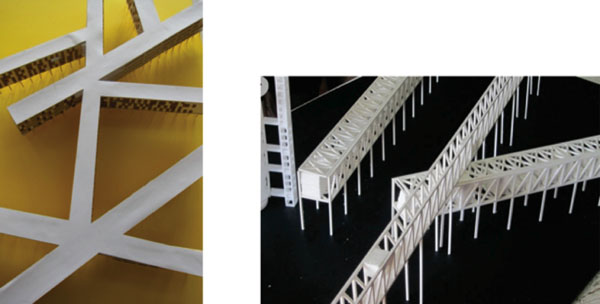 ). We have identified the distinctive residential fragments, residential pockets of the city as a resistant basis for certain tactics of transformation arising from both everyday situations and hypothetical visions and the utopian energy of the 1970-ties expressed through the concept of collective form of Fumihiko Maki [11Maki F. Investigations in collective form Washington University,
School of Architecture 1964, [Online] Available from:
http://librarywustledu/units/spec/archives/photos/maki/makipart1
pdf [Accessed August 2013] 1964.]. Accepting the concept of megaform, as a formal system that revise the hierarchal system of the city, we see a potential in the translation of it’s fundamental principles on a local level, on a level of urban fragments and housing pockets.
). We have identified the distinctive residential fragments, residential pockets of the city as a resistant basis for certain tactics of transformation arising from both everyday situations and hypothetical visions and the utopian energy of the 1970-ties expressed through the concept of collective form of Fumihiko Maki [11Maki F. Investigations in collective form Washington University,
School of Architecture 1964, [Online] Available from:
http://librarywustledu/units/spec/archives/photos/maki/makipart1
pdf [Accessed August 2013] 1964.]. Accepting the concept of megaform, as a formal system that revise the hierarchal system of the city, we see a potential in the translation of it’s fundamental principles on a local level, on a level of urban fragments and housing pockets.
Novo Maalo neighborhood was registered for the first time in the city plans in the beginning of the twentieth century. Its urban morphology can easily be distinguished from the informal schemes of the traditional city and the planned
schemes of the modern city. The district represents a kind of superimposition of regulation and spontaneity. Straight streets that are intersected at irregular sections with houses that have preserved the traditional models of living, but with an expression that converges to the European references. In what way, after 100 years of its existence on the verge of disappearance, we can establish a new dialogue with authentic values of Novo Maalo neighbourhood?
With the introducing of the City Ring, its territory was divided between the two sides of the ring, while with the progressivistic visions of the city (post-war and post-earthquake reconstruction), it was anticipated to be eliminated in order that it could become, with the new post-socialistic revisions of the city, the basis for the new physical densification. In both cases, the neighborhood is being lost, physically or by transformation of the original proportions of the spatial and social substance.
Although devastating processes of long term transition of the urban fragments of the city are read in the neighbourhood, it still has spatial and social capacity, possesses an atmosphere and a specific quality of a distinctive place- historicism, relationism and identity. For Christmas Eve, fires are lit in different neighborhoods and the citizens gather around them (Fig. 7 ). There is a national tradition, which although a subject of criticism, shows the authentic wish of the citizens to express their affiliation and connection with the place. In Novo Maalo neighborhood, Christmas Eve is celebrated at a specific place, at the intersection of five streets, whose axes touch the modest neighborhood fountain in the middle, leaving at the same time “contemplative” spatial pockets. It is specifically that place that has an authentic
). There is a national tradition, which although a subject of criticism, shows the authentic wish of the citizens to express their affiliation and connection with the place. In Novo Maalo neighborhood, Christmas Eve is celebrated at a specific place, at the intersection of five streets, whose axes touch the modest neighborhood fountain in the middle, leaving at the same time “contemplative” spatial pockets. It is specifically that place that has an authentic
value, on one hand everyday, while on the other hand, archetypical, ageless, so that when one passes through it, one feels the invisible, spatial star below one’s feet with the power to organize, but also transcede one’s everyday spatial experience (Fig. 8 , Fig. 9
, Fig. 9 ).
).
In a number of examples, the tactics arising from this procedure will be shown:
From an urban fragment to a new urban artifact (Kristijan Mitrevski): Through inversion of the street plans from void into sold, a new configuration is obtained, as an upgrade of the street system into a new collective mega form. At the ground floor, the streets are porches of the storey platforms for elementary residential units (Fig. 10 ).
).
From street models to a new collective form (Katerina Elezi): Through the inversion of the street system, from void to solid and its successive decomposing and differentiation of the main street directions along height, a new three-dimensional interpretation of the street model of Novo Maalo is obtained. The new configuration consists of five
horizontal towers placed on vertical pylons of communications (Fig. 11 ).
).
Upgrading Novo Maalo, Skopje (Petrov Gordan): Upgrading refers to placement of residential bridges over the existing residential texture. The position of the bridges arises from the main street plans of Novo Maalo. These are placed beside three streets that mutually intersect. The two street directions are at the same height and are the basis for housing, while the third is placed as the highest and connects the neighborhood with the Vardar river. In this way, through decomposition, selection and extension of the existing street plans, a new city installation is obtained (Fig. 12 ).
).
Sequential connection as a tactic of transformation of the residential texture (Aurora Saidi): In this example, the street model is not the basis for transformation of the residential texture but the units of the block, the lot. The lots are a critical element for the transformation of the texture.
Through the procedure of sequential connection, a number of neighboring lots are connected along a horizontal line
and are extruded along the vertical line. Three height plans are differentiated: Low zone (1 – 2 storey) composed of an integral form connecting all the lots; Intermediate zone (3 - 4 storey) segmented into groups of lots; High zone (5 – 9 storey) differentiated into individual lots – towers arising from the main mass. In this way, a new rhisomatic mega-form, which develops and unfurls from the existing one, is obtained (Fig. 13 ).
).
Incision, cutting the city, connecting the urban fragments, taking Skopje as an example (Aleksandar Petanovski): This project does not refer to Novo Maalo, but results from the experience gathered from this neighborhood. It establishes a linear configuration in transverse direction of the former longitudinal city in its east sector and in that way, it connects the different programmatic and morphologically isolated fragmentary zones that exist today. The procedure of
incision (cutting) of the city and superimposing of linear formations enables spatial and programmatic upgrading and simultaneous connection of different spatial programmatic positions of the city. Incision is a linear sequence, not as a system but as another fragment that re-interpretes the existing fragments (Fig. 14 ).
).
Through a number of projects, Novo Maalo has been transformed from an everyday place into a new hypothetical place, not through the cause-effect relation of the semantic and the spatial system but through its inversion, a kind of “complete forgetting” of the existing situation as an efficient tactic in the transformation of our reality.
CONCLUSION
In the “Memento” movie (Memento, 2000) directed by Christopher Nola, the main figure Leonard Shelby cannot remember the events that happened in his recent past [12 Memento Directed by Christopher Nola USA: Newmarket Capital Group,Team Todd, I Remember Productions 2000 2000.]. He loses his recent memories and he is forced to reconstruct the events from his past again from the story that follows. For that purpose, he takes records of the events experienced, takes photos and tattoos the data in the form of instructions
and diagrams on his body in order that he could interpret them again (Fig. 15 ). He has an anterograde amnesia, a form of amnesia that involves loss of ability to create new memories and partial or total inability to recall recent past, while the long term memories prior to the event that has caused the amnesia remain untouched. This is contrary to the retrograde amnesia when most of the memories created in the period prior to the event, which is the cause of loss of memory, are lost, while new memories can still be created. Both types of amnesia can occur in the same patient [13 Anterograde Amnesia, [Online] Avaible from:
http://enwikipediaorg/wiki/Anterograde_amnesia [Accessed
August 2013] ].
). He has an anterograde amnesia, a form of amnesia that involves loss of ability to create new memories and partial or total inability to recall recent past, while the long term memories prior to the event that has caused the amnesia remain untouched. This is contrary to the retrograde amnesia when most of the memories created in the period prior to the event, which is the cause of loss of memory, are lost, while new memories can still be created. Both types of amnesia can occur in the same patient [13 Anterograde Amnesia, [Online] Avaible from:
http://enwikipediaorg/wiki/Anterograde_amnesia [Accessed
August 2013] ].
His loss of memory refers to the inability of his memory to receive new information, new events. His records are an attempt toward a creation of an exo-body memory, mnemo technique, of the events that he has to follow. However, each successive interpretation displaces the authentic narrative. The film arouses a number of questions: Does the inability to remember produce a multitude of records for the memory? Is the image of the material trace in the same way displaced, turned upside down, in each subsequent period? Does the transformation of our physical reality arise from our memory or our forgetting?
Through the “Memento” movie story, one can recognize the two contradictory, but complementary processes of the state of loss of memory as an anterograde amnesia: first, taking records out of fear from forgetting and as a mode of overcoming the loss of memory, second, displaced, inverse reading of what has been written as part of the active process of forgetting. In that way, that which produces the record displaces its meaning at the same time as an inability for an authentic continuity (Fig. 16 ).
).
It is exactly this contradiction of the process of forgetting that one can also recognize in the processes of transformation of urban artifacts as well as the possibility to use them as a tactic for their transformation: the different records of the physical structure are part of the processes of actualization of the city architecture in the same way as their displaced reading. It seems that, in certain periods, the city is more a product of disturbance than a cause and effect process. Physical traces, the urban artifacts, of a previous layer are always read through new layer of oblivion. In that way, in the geography of the city, the traces of forgetting the city are read.
In the thirties of the twentieth century, Salvador Dali formulated the method of paranoiac-critical action as a rational colonization of the irrational [15Dali S. The Conquest of the Irrational [Online] Available from: http://feastofhateandfearcom/archives/salvador_2html [Accessed August 2013] ]. This procedure is understood as an extension of visual games, based on the
double image (Fig. 17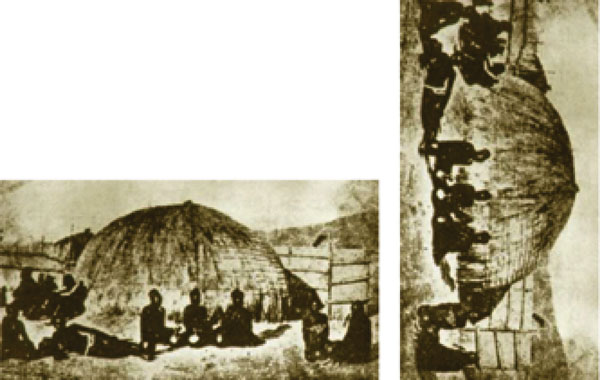 ). According to Dali, simulating paranoia, one can sustematically undermine the rational view of the world, which becomes continually subjected to associative transformations. The primary function of the paraoiac-critical method is to produce images of surprising and authentically unknown nature in such a way that the real world from which they arise loses its validity. This method leads to a world of a continuous flux in which objects dissolve from one state into another, solid things become soft, while shapeless things assume form. In a similar way, forgetting may lead one to a critical overestimation of the reality whereat one can interpret the city architecture again and again through the “conquest” of forgetting.
). According to Dali, simulating paranoia, one can sustematically undermine the rational view of the world, which becomes continually subjected to associative transformations. The primary function of the paraoiac-critical method is to produce images of surprising and authentically unknown nature in such a way that the real world from which they arise loses its validity. This method leads to a world of a continuous flux in which objects dissolve from one state into another, solid things become soft, while shapeless things assume form. In a similar way, forgetting may lead one to a critical overestimation of the reality whereat one can interpret the city architecture again and again through the “conquest” of forgetting.
CONFLICT OF INTEREST
The authors confirm that this article content has no conflict of interest.
ACKNOWLEDGEMENTS
The authors are grateful to the master students of University ”Ss. C Cyril and Methodius” at Faculty of Architecture in Skopje: Kristijan Mitrevski, Katerina Elezi Gordan Petrov, Aurora Saidi and Aleksandar Petanovski, for their
inspired project work on the topic “Tactics of Transformation on Residential Texture”.
REFERENCES
| [1] | Nowak W. Foreword. In: Bardett R, Sudjic D, Eds. Living in The Endless City. London: Phaidon Press Limited 2011; p. 6. |
| [2] | Rossi A. The Architecture of the City. UK: The MIT Press 1982. |
| [3] | Rossi A. A Scientific Autobiography. UK: The MIT Press 1984. |
| [4] | Maddox GB, Balota DA, Coane JH, Duchek JM. The role of forgetting rate in producing a benefit of expanded over equal spaced retrieval in young and older adults. Psychol Aging 2011; 26(3): 661-70. [Online]. [. Available from: http://en.wikipedia.org/wiki/Forgetting]. [http://dx.doi.org/10.1037/a0022942] [PMID: 21463056] |
| [5] | Connerton P. Seven types of forgetting. Mem Stud 2008; 1: 59. [Accessed October 2014]. [http://dx.doi.org/10.1177/1750698007083889] |
| [6] | Hertzberger H. Lessons for students in architecture 1991. |
| [7] | Guibert JB. Arles amphitheater before houses were cleared (starting 1825), postcard of old engraving, scanned by Robert Schediwy, [Online] Available from: http://commonswikimediaorg/wiki/File:ArlesGuibertJPG [Accessed August 2013] 1825. |
| [8] | Presumed original ground-plan of Diocletian's Palace, [Online] Available from: http://wwwflickrcom/photos/21711359@N08/3968358431/, [Accessed August 2013] |
| [9] | Bakalchev M. Housing as urban fragment of Skopje taken as an example (in Macedonian) “SS Cyril and Methodius” University of Skopje: Faculty of Architecture 2004, Unpublished doctoral dissertation . 2004. |
| [10] | Skopje resurgent: the story of a united nations special fund town planning project. New York: United Nations 1970. |
| [11] | Maki F. Investigations in collective form Washington University, School of Architecture 1964, [Online] Available from: http://librarywustledu/units/spec/archives/photos/maki/makipart1 pdf [Accessed August 2013] 1964. |
| [12] | Memento Directed by Christopher Nola USA: Newmarket Capital Group,Team Todd, I Remember Productions 2000 2000. |
| [13] | Anterograde Amnesia, [Online] Avaible from: http://enwikipediaorg/wiki/Anterograde_amnesia [Accessed August 2013] |
| [14] | Rosenberg T. Sunday Dalí: Paranoiac Visage, 1931 One Surrealist a day Blog, 2010 [Accessed February 16, 2012] Available from: http://onesurrealistadaycom/post/480421998/paranoiac-visage 2010. |
| [15] | Dali S. The Conquest of the Irrational [Online] Available from: http://feastofhateandfearcom/archives/salvador_2html [Accessed August 2013] |





